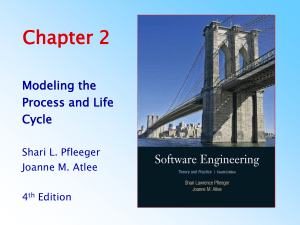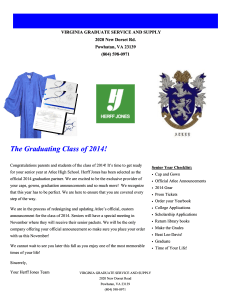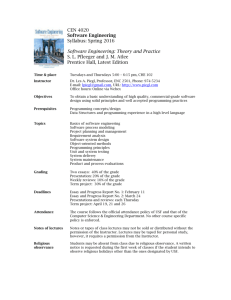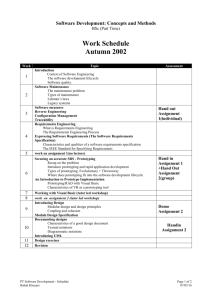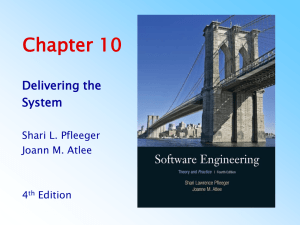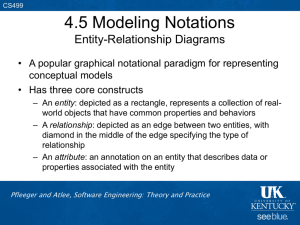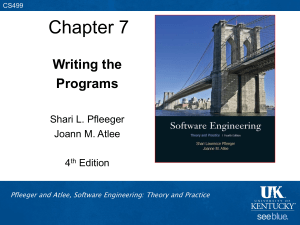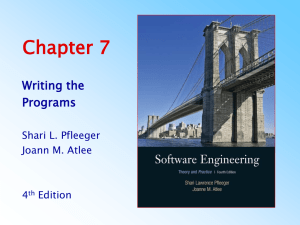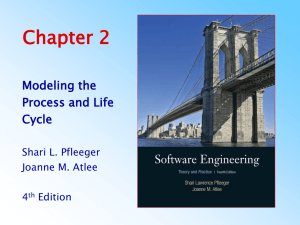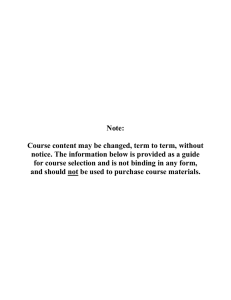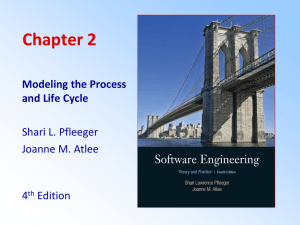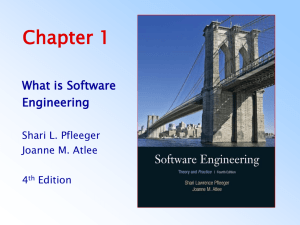Software Process Modeling
advertisement
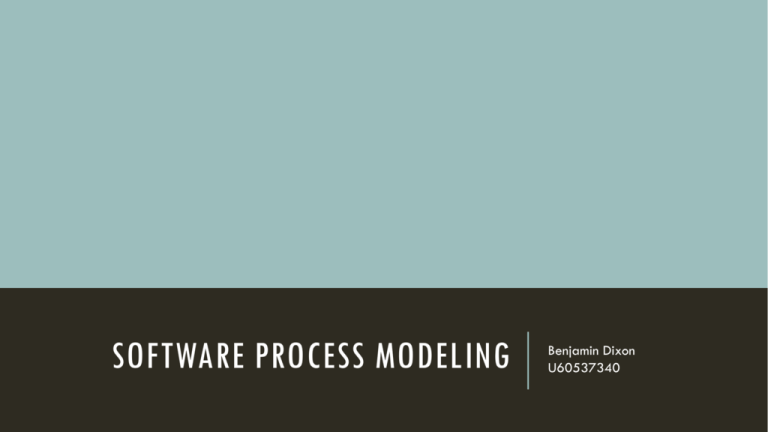
SOFTWARE PROCESS MODELING
Benjamin Dixon
U60537340
PROCESS CHARACTERISTICS AND MAJOR
ACTIVITIES
Characteristics
Major Activities
Software Process: “A software process is a
set of related activities that leads to the
production of a software product.”
Software specification The functionality of
the software and constraints on its
operation must be defined.
Software design and implementation The
software to meet the specification must be
produced.
Software validation The software must be
validated to ensure that it does what the
customer wants.
Software evolution The software must
evolve to meet changing customer needs.
Includes:
Requirements
System Design
Program Design
Coding/implementation
Unit/integration/system testing
Delivery
Maintenance
SOFTWARE PROCESS MODELS
Prescriptive
Descriptive
A prescriptive model defines the path software
development should follow ahead of time.
A descriptive model tracks the real progress of
the project as it is ongoing.
Reasons for Modelling
Organize efforts
Track progress
Track changes in requirements
Keep up with deadlines
THE WATERFALL MODEL
Description
Separates the development process into the
sections shown on the left.
Each segment proceeds strictly after the
previous.
Pros
Easier for managers and onlookers to
understand
Cons
Inflexible
Reality
Segments actually overlap and repeat
constantly
Peter Kemp/ Paul Smith – Wikipedia.org
WATERFALL MODEL WITH PROTOTYPING
Description
A type of Waterfall Model that involves
creating a partial product and reworking it over
and over.
Pros
Allows more flexibility.
Allows for product verification at multiple
phases.
Cons
Can increase overhead time/effort costs.
Reality
Improves upon the original Waterfall method.
Gary Shute, University of Minnesota
THE V-MODEL
Description
Breaks development into 3 parts: execute, write,
check
Execute: defines project goals and design
Write: write the code and implement the system
Check: unit testing, integration testing, system testing
Pros
Each testing phase connects back to its
associated design phase, illustrating the
iteration process.
Cons
Harmonicss.co.uk
Unfortunately, it is not flexible to change.
PROTOTYPING MODEL
Description
Quickly develop prototypes matching
requirements.
Customer can evaluate prototype.
Either refine or reject the prototype.
Pros
Customers are more involved in the final
product.
istqbexamcertification.com
Cons
Can spend a lot of wasted time on rejected
prototypes.
OPERATIONAL SPECIFICATION MODEL
Description
Requirements are assessed prior to design and
implementation.
Allows requirements to be solidified and refined
prior to spending time implementing incorrectly.
S. Pfleeger and J. Atlee
TRANSFORMATION MODEL
Description
Codifies requirements into a formal document
Formal requirements are transformed
incrementally into a deliverable system
S. Pfleeger and J. Atlee
PHASED DEVELOPMENT MODEL
Description
Systems are produced in different phases
spaced over time.
Gets products out quicker.
Allows the customer to have something usable
while the rest of the system is being developed.
S. Pfleeger and J. Atlee
INCREMENTAL AND ITERATIVE MODELS
Incremental
Produce individual subsystems one at a time,
adding functionality to the overall product over
time.
Iterative
Produce a full system, adding/changing
subsystem functionality over time.
S. Pfleeger and J. Atlee
SPIRAL MODEL
Description
Combination of development and risk
management.
Each quadrant of the spiral represents a
different activity:
Evaluating Risks/Alternatives
Developing/Testing
Planning
Goal Planning
S. Pfleeger and J. Atlee
AGILE METHODS
An alternative method to software
development.
Improves flexibility in the development
process.
Follows the principles of the Agile
Manifesto:
Individuals and interactions are greater than
process and tools
Focus on working software rather than
documentation
Customer collaboration over contracts
Respond to change rather than plan
Examples of Agile Programming
Extreme Programming (XP)
Crystal
Scrum
Adaptive Software Development (ASD)
12 FACETS OF XP
The planning game
Small release
Metaphor
Simple design
Writing tests first
Refactoring
Pair programming
Collective ownership
Continuous integration
Sustainable pace
On-site customer
Coding standard
TOOLS FOR PROCESS MODELING
Notation: dependent on goal of the model
Text-based or graphical flow-charts
Different types of modeling
Static Models
Dynamic Models
S. Pfleeger and J. Atlee
STATIC MODELING
Name
Synopsis
Complexity type
Data type
Artifact-state list
parked
Lai Notation
Activity
Sequence
Process model
Resource
Control
Policy
Organization
initiated
moving
Car
This is the artifact that represents a class of cars.
Composite
(car_c, user-defined)
((state_of(car.engine) = off)
(state_of(car.gear) = park)
(state_of(car.speed) =
stand))
((state_of(car.engine) = on)
(state_of(car.key_hole) =
has-key)
(state_of(car-driver(car.))
= in-car)
(state_of(car.gear) = drive)
(state_of(car.speed) =
stand))
((state_of(car.engine) = on)
(state_of(car.keyhole) =
has-key)
(state_of(car-driver(car.))
= driving)
((state_of(car.gear) =
drive) or (state_of(car.gear)
= reverse))
((state_of(car.speed) =
stand) or
(state_of(car.speed) = slow)
or (state_of(car.speed) =
medium) or
(state_of(car.speed) =
high))
Car is not moving, and
engine is not running.
doors
engine
keyhole
The four doors of a car.
The engine of a car.
The ignition keyhole of a
car.
The gear of a car.
The speed of a car.
Car is not moving, but the
engine is running
Car is moving forward or
backward.
Sub-artifact list
gear
speed
Relations list
car-key
car-driver
S. Pfleeger and J. Atlee
This is the relation between a car and a key.
This is the relation between a car and a driver.
DYNAMIC MODELING
Shows resources at each step of
development
Simulates alternatives and changes
Systems dynamic approach
Improves productivity
Shows how changes in one thing affect other
things
S. Pfleeger and J. Atlee
PRACTICAL PROCESS MODELING
Marvel Specification Language (MLS)
TICKET:: superclass ENTITY
status : (initial, open, referred_out, referral_done,
closed, fixed) = initial;
diagnostics : (terminal, non_terminal, none) = none;
level
: integer;
description : text;
referred_to : link WORKCENTER;
referrals
: set_of link TICKET;
process
: link PROC_INST;
end
diagnose [?t: TICKET]:
(exists PROC_INST ?p suchthat (linkto [?t.process ?p]))
:
(and (?t.status = open}(?t.diagnostics = none))
{TICKET_UTIL diagnose ?t.Name}
(and (?t.diagnostics = terminal)
(?p.last_task = diagnose)
(?p.next_task = refer_to_WC3));
(and (?t.diagnostics = non_terminal)
(?p.last_task = diagnose)
(?p.next_task = refer_to_WC2));
S. Pfleeger and J. Atlee
Class
definition
for trouble
tickets
Tool envelopes, classes, rules
Three main concepts define a process
description
rule-based
Object-oriented
Interface between process and external systems
Rulefor
diagnosing
ticket
REFERENCES
Sommerville, Ian. Software Engineering. Boston: Pearson, 2011. Print.
S. Pfleeger and J. Atlee, Software Engineering:Theory and Practice. Upper Saddle River [N.J.]: Prentice
Hall, 2010.
